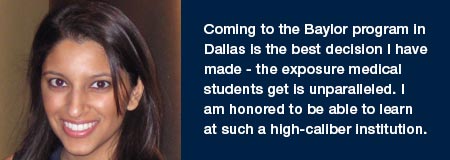Undergraduate Medical Education
Educating the next generation of physicians. At a time when physicians are needed most, our nation faces a looming shortage – up to 200,000 by 2020, according to the Association of American Medical Colleges. The situation is worse for Texas, where the ratio of primary care physicians per 100,000 people already ranks third from the bottom. In fact, in North Texas alone there are 30 percent fewer physicians than are needed, a shortfall that will likely grow to 50 percent by 2020. Baylor University Medical Center is determined to avert this crisis. Joining forces with Texas A&M Health Science Center College of Medicine, we have established a new clinical training program in Dallas for third- and fourth-year medical students. The program began with 24 students in December 2011, with increased enrollment planned over the next several years.

Areas of Need
FACULTY PRECEPTORSHIPS
It takes an outstanding faculty to sustain a successful teaching hospital. Baylor is blessed with an exceptional group of faculty physicians committed to teaching future clinicians. These physicians teach because they believe it is their duty and calling. Yet teaching requires that they take time away from their patient care obligations. With physicians’ practices demanding more of their time, it is becoming increasingly difficult to fill this critical need.
LEARNING RESOURCE CENTER
Every medical student must complete competency exams to assess and verify medical knowledge. Our medical students need an interactive educational and assessment lab to prepare for and complete these exams. This center would allow for collaboration between students in sharing best practices, further enhancing their clinical knowledge. The center would also be outfitted with video conferencing capabilities and other appropriate technology to increase the quality of our students’ educational experience.
STANDARDIZED PATIENTS
Hands-on training is vital for medical students. To receive this training, our students conduct Objective Structured Clinical Exams on standardized “patients”: individuals who have been trained to perform as if they were actual patients. These highly motivated actors contribute a valuable service in helping us educate the next generation of healthcare professionals.
SIMULATION LABS
Simulation-training labs use electronic mannequin simulators to create realistic patient care scenarios that allow physicians and nurses to practice assessments and interventions. The mannequins realistically respond to participants’ actions, providing immediate feedback for interventions performed or missed. Static mannequins simply cannot provide such dynamic learning. Instructors can tailor the patient scenario to fit the skill level of the practitioners and give each group unique challenges to determine strengths and weaknesses.
Studies have shown that training with simulators leads to safer practitioners who respond more confidently, appropriately and effectively to many patient care scenarios.
Your contribution can help Baylor Health Care System Foundation expand facilities, find new treatments, train more doctors and support more patients with hematologic cancers. Please give online or call 214-820-3136 to discuss your gift today.
Read More
facts
Medical education has been part of our institution since 1903.
Baylor welcomed its first class of 24 third year medical students as a Clinical Campus of Texas A&M Health Science Center College of Medicine in December 2011.
73 physicians on the Baylor medical staff are graduates of Texas A&M Health Science Center College of Medicine.
Over the course of a career, a physician can affect the lives of 50,000 to 100,000 people.